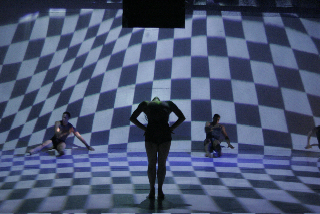|
 |
|
|
 |
 |
HammerChoreography/concept, Benoit-Swan Pouffer Music, Stefan Zazzera Live Recordings, Etnoise Soundgenerator Studio Costume/Scenic Design, Junghuyn Georgia Lee Lighting, Jim French Projection Design, Adam Larsen History rules us, history and remembered images, moments of insight. We bring those to everything, including dance performances. Observing "Hammer", a flash of memory brought the televised images of the Berlin Wall coming down (in November, 1989). Here were the first, nearly ineffectual, blows struck by a few sledgehammer-wielding individuals, surrounded by thousands of cheering, freedom-craving Germans. The wall was frustratingly resilient, of reinforced concrete. And, although monster machines were eventually needed to chew away the oppressive tonnage, the tool of first resort was the hammer. Benoit-Swan Pouffer, artistic director of Cedar Lake, takes the hammer as theme for his ballet. He comments in the program that as a young adult he discovered Friedrich Nietzsche's Twilight of the Idols, which proposes challenging life with a hammer. A Nietzsche quote, projected on the back wall as the dance begins: "To pose questions with a hammer and listen to the sound it makes. That which would like to stay silent has to become audible." This ballet is a story about using the hammer to challenge life, to barge into imagination, to break into a creative world. The dancing is superb and the images arresting. The performance can be enjoyed for its texture, sound, or purely for its beautiful movement. But there is much more going on for an audience willing also to become intellectually involved. The hammer itself as a symbol 䴋 held, tossed, pounded with, imaged in projections, and held aloft 䴋 is a small sledge hammer, nothing so refined as a claw hammer or a ball-peen or an ice mallet. It's a short, three-pound rock breaker. It sits stage left, lights not yet up, while the audience settles. The first dancer onstage sits, back to the audience, and takes up the hammer to loudly pound a rhythm into the floor. She is joined by more and more dancers 䴋 women in shirtwaist dresses and men in slacks and shirts. They begin to crowd their space 䴋 an irregular dock that projects two-thirds of the way across the watery-looking stage, in the shadow shape of an industrial building. It is, for the time being, their limit, they restrict their movement to its angular shape. The corps work is phenomenal here 䴋 the urban pack moving unanimous in split-second contractions and soaring lifts. The focus shifts to vignettes, glimpses of relationships, and as dancers take on individual identities (Heather Hamilton is both a terrific dancer and actress), the littleness of their lives flickers in circumscribed drama or inferred envy and changing partners. They toe the edge of the dock and look beyond to the larger stage, tentative and curious. Some dancers have, while all attention was on the crowd, insinuated themselves onto the unlit portion of the stage and they begin to move slowly, almost rumors, in the near dark. As the crowd explores and retreats from the idea of escaping their dock, one of these dancers not part of the crowd (Roderick George) coaxes a dancer (Jason Kittelberger) away, dancing together and in parallel, onto the larger stage. One by one and two by two, the other dancers find they can leave the shadow, until all but one has stepped off. As she waivers, indecisive yet dancing to the end of the dock, the dancers remove the dock a plank at a time, right up to the board under her feet, and as they being to lift that, she must step off into the newness of what now seems huge. Celebration and exploration! A few at a time, dancers leave briefly and return in new costumes, freeing costumes, and dance. We have barged into imagination, broken into the creative world, into a theater where the floor curves up the back wall so that it can be run up, used as a slide, or used as a projection screen without boundary. The music is disorienting, seductive, beautiful and sometimes challenging, and it affects a sense of wonderment. It is essential. From here the tale proceeds as if in chapters. The narrative is not linear so much as it is periodic 䴋 a ballet of incidents and episodes that explore symbol and imagery. It combines imaginative dance and technical virtuosity. Coordination of the brilliantly conceived projections and dancers is precise. To choose one example, images of carp miraculously swim forth from the spot, the exact spot, where the hammer, the symbol of questioning, is tossed. They swarm, simply swarm, around the dancer, like possibility, like life released, like surprise. There is nothing indistinct or pale about them; they are convincing and vibrant, fully figuring in the dance. And typical of the clever segues between episodes, when the very large shadow of one fish hovers, swimming very slowly, above the dancers as this chapter of the imagination develops, it brings to mind the shark. That this is not a linear narrative is challenging, and if the dancers were not so engaging, the tale would be lost. It is complex and demands attention. There is a circus-with-a-purpose sensibility. The company is on-board and dedicated, and it is their focus that carries the audience through a few wan moments and into unfamiliar visuals. Dance is their territory but projection design (and precise coordination), lighting, music, live manipulated video are very much part of the remarkable experience.
 Jessica Lee Keller in HAMMER Photo © & courtesy of Paul B. Goode |
|
 Jason Kittleberger with Left to right
Jolene C. Baldini, Jessica Coleman Scott, Heather Hamilton, Kristen Weiser, Jessica Lee Keller Photo © & courtesy of Paul B. Goode |
|
|
|



